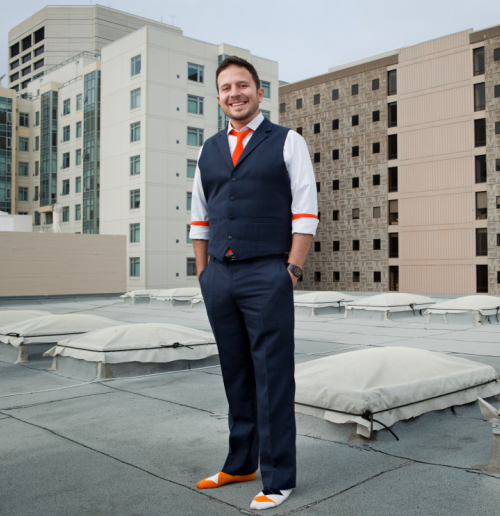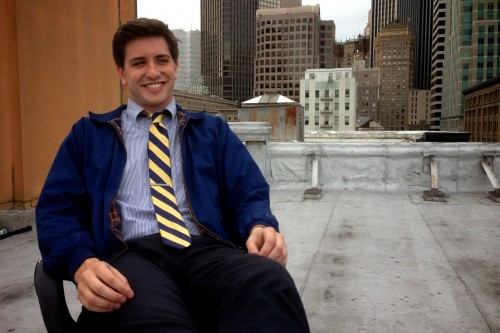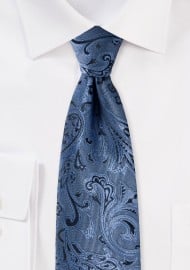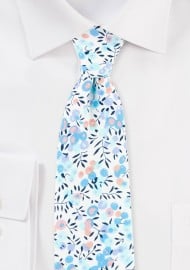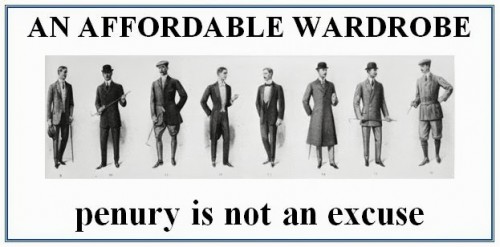
Since I started my Menswear Insider series, I have enjoyed interviewing several entrepreneurs that have launched either a menswear clothing brand, or online retailer. While it is fun, interesting, and inspiring to hear their stories, I am equally excited to branch out a little with today’s interview feature. Today I am interviewing one of the most notorious thrifter in the country, Guiseppe Timore, founder of An Affordable Wardrobe. For the past several years he has shared his passion for finding bargain deals on elegant, high-end clothing pieces via his blog, and later on also opened a brick-and-mortar thrift shop in Massachusets.
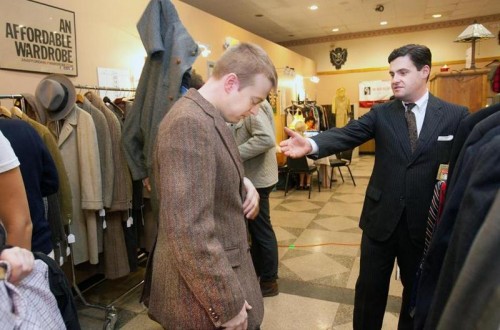
Tie-a-Tie: Hi Giuseppe, thanks for joining me on my Menswear Insider column. You have a very Italian name. Tell me about your heritage?
Giuseppe: I come from a 100% Italian family. I used to joke with my friends about being a “pure bred”. Both my mother’s parents and my father’s father were born there. Growing, we lived with my mother’s parents, and the neighborhood was full of native Italians. We all attended Catholic schools and went to church, and heard as much Italian spoken as we did English. I think my mother, though born here, may have spoken Italian before she spoke English.
Tie-a-Tie: Now, Italians are often stereotyped as being stylish and well dressed. You being a well dressed man of Italian decent, do you think that being stylish is nature or nurture?
Giuseppe: I think that having style is somewhat inherent in one’s personality, but that doesn’t mean there’s nothing to learn. Style is an ever evolving thing, and the most truly stylish among us never stop learning and changing. I don’t think being Italian necessarily guarantees that one is stylish, though I suppose it can’t does’t hurt.
Tie-a-Tie: Have you always cared about dressing well? What inspired you to start your An Affordable Wardrobe?
Giuseppe: I guess I have. From a very young age, I was always interested in “dressing up”. I liked to wear jacket and tie, and would relish any excuse to do so. The older I got, the less I cared what people thought of it.
I started an Affordable Wardrobe to fill what I saw as a gap at the time in menswear writing and commentary. Being interested in clothing, I had always read the magazines, and later the blogs. While many of them served as a source of ideas and inspiration, none of them showed anything but very expensive stuff at full price, stuff that was way out of my reach.
Over the years, I had developed quite a knack for sourcing those very same things on nearly no money. I knew it could be done, and I wanted to be a voice for all the elegant, stylish men who just might not have that much money.
Tie-a-Tie: You are infamous for being a savvy thrift shop buyer. Tell me about your most memorable thrift shop experience.
Giuseppe: I get that question a lot, but it’s not an easy one to answer. One of the things about thrift shopping is that you come across so many great things that picking a “favorite” can be impossible. There’s always something new, and the element of surprise keeps it fresh. I once found a Barbour jacket new with tags for $10. Just recently I picked up a bespoke Chesterfield coat made in Boston in 1935. Even as we speak, I’m wearing a handmade flannel suit from the Andover Shop and an Italian tie from Barney’s New York. All great finds, but who knows what I might run into tomorrow?
Tie-a-Tie: How do you find these kind of pieces, and what tips do you have for our readers interested in finding great deals on designer menswear items?
Giuseppe: Firstly, you really have to know what the good stuff is. Educate yourself about quality, fabric and construction. Knowing good labels helps, but learning to recognize quality itself, regardless of brand, is infinitely more helpful It like the proverb giving a man a fish or teaching him to fish.
Secondly, be persistent, and don’t get discouraged when you strike out. Truthfully, when you shop this way, constantly hunting for bargains or digging in thrift shops, you’re ten times more likely to walk away empty handed as you are to “score”. You can’t let it discourage you, you just have to keep coming back.
Tie-a-Tie: Now, if there was no budget, what designer/brand do you value most and why?
Giuseppe: My own personal style derives mostly from a traditional East Coast look, so I like Brooks Brothers and J. Press quite a lot. Polo is a favorite too. But if I could only wear one “brand” and had unlimited money, I would get everything at the Andover Shop in Harvard Square. Not only is the place steeped in “cool” history as a result of its endless list of storied customers, but it’s distinctive in just the right way. Mostly, they do East Coast traditional, with its attendant “go to hell” pants and ribbon belts. But there is an extra level of quality and taste to everything there. Fabrics are gorgeous, and the house style combines just the right British details into the mix in a way that no other shop or “brand” does. It’s perfect.
Tie-a-Tie: Speaking of “no budget”, what is your most expensive clothing piece that you didn’t buy at a thrift shop? Was it worth the price?
Giuseppe: I think the Brabour jacket I have now might be the most expensive single piece of clothing I ever bought new, but I even got that o deep sale at an outlet store for $150. It was worth it, though. I wear that jacket to death, sometimes to shovel snow, and sometimes over coat and tie.
Tie-a-Tie: You have since opened your own thrift store. What do you like more, buying or selling menswear pieces?
Giuseppe: The hunt can be the most fun part of all this once you get into it, and obviously selling things and making money is nice too. But the best part about doing this kind of work is how happy you can make people by helping them get something top quality that they never thought they would be able to own. It’s really gratifying.
Tie-a-Tie: As someone owning your own men’s clothing business, what advice would you give someone interested in opening a brick and mortar store in the menswear industry?
Giuseppe: You have to be willing to work crazy hours for terrible pay, but I guess that’s true for any dedicated small business owner these days. If you don’t love what you’re doing, it’s not going to work, simple as that.
Tie-a-Tie: What are your plans and goals for your business in 2014?
Giuseppe: To stay in business! (joking, kind of…). Seriously, though, I would love to get to the point with my own business where I could quit the other job I have and do this full time.
Tie-a-Tie: The word about your business is certainly spreading… Now, where do you see yourself 10 years from now?
Giuseppe: In a thrift shop, pulling a bespoke suit out of a dirty bin from under a heap of old sweatpants and tee shirts.
Tie-a-Tie: Great answer. You certainly love what you do and turned your passion into your every day job. Thanks for meeting with me today.
Giuseppe: Thanks you as well.
Interviewed by tie aficionado and Tie-a-Tie founder Hendrik.

